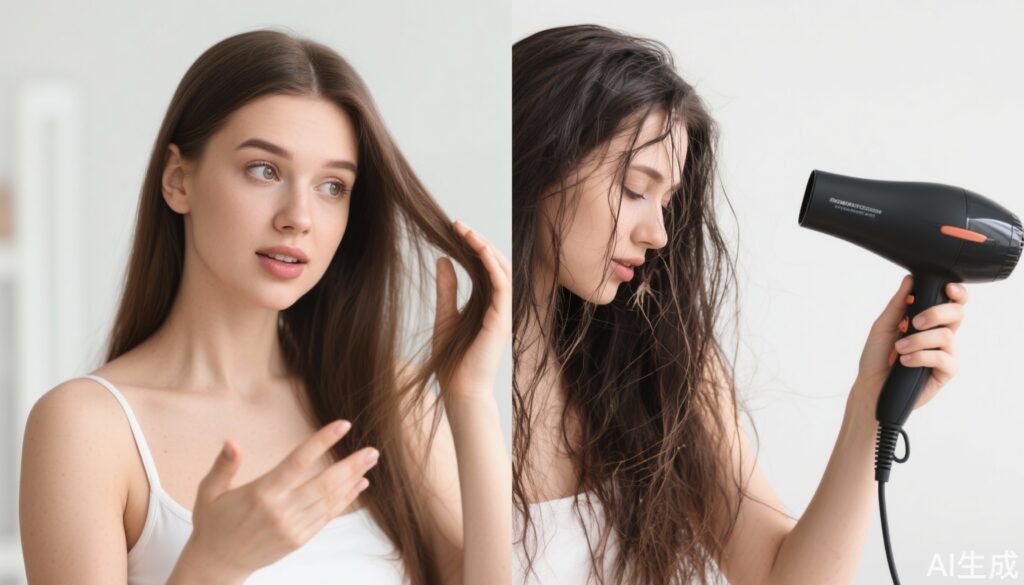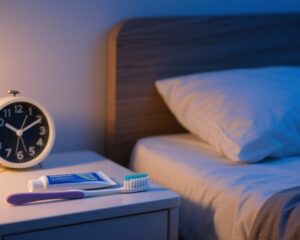Introduction: The Hair-Drying Dilemma
After washing your hair, the familiar question arises: should you let it air dry naturally, or use a blow-dryer to speed up the process? This simple-sounding decision has more implications than you might think, affecting not only how your hair looks but also its long-term health and the wellbeing of your scalp.
Hair care routines are deeply personal and influenced by lifestyle, climate, and hair type. Yet the choice between natural drying and blow-drying is often a source of confusion or habit rather than informed decision-making. This article explores the scientific basis behind these drying methods and offers practical guidance to help you make the best choice for your hair health.
Scientific Evidence: How Drying Methods Affect Hair Structure
To understand why blow-drying and natural drying impact hair differently, we first need to look inside a single hair strand.
Hair Microstructure and Its Protective Shield
A human hair shaft, visible as a single strand, is composed of layers: the innermost medulla (not always present), the cortex (contains fibrous proteins and pigments), and the outermost layer called the cuticle. The cuticle is made up of overlapping flat cells resembling tiny armor plates, which protect the inner cortex and maintain moisture balance.
Under a microscope, intact cuticles appear tightly closed and smooth, lending hair its shine and strength. However, when hair becomes wet, these cuticles open up, like small mouths facing upward, making hair more vulnerable.
Blow-Drying: Speed at a Cost
Blow-dryers use heated air to evaporate water rapidly. While this quick drying is convenient and facilitates styling, the heat and airflow affect the cuticle integrity. Hot air can open the cuticle more widely and force moisture out too fast, causing the hair to lose water rapidly.
Repeated exposure to high temperatures can damage the cuticle, leading to lifted, roughened scales that increase friction between hairs, resulting in breakage, split ends, and a dull appearance. Heat also disrupts disulfide bonds in keratin proteins within the cortex, weakening hair’s structural integrity and making it more prone to brittleness and fracture.
Additionally, heat can degrade melanin — the pigment that gives hair its natural color. For many East Asians with dark hair, this can cause unwanted yellowing or fading after frequent blow-drying.
Natural Drying: Gentle but Slow
Allowing hair to air dry avoids thermal stress, helping maintain the cuticle’s protective closure and preserving moisture within the hair shaft. This method promotes hair strength, shine, and softness over time.
However, natural drying takes longer and, in cold or damp environments, exposes hair and scalp to prolonged moisture exposure and cooler temperatures, which may cause scalp irritation or discomfort and even contribute to scalp sensitivity or infections in some cases.
Effects on Scalp Health
The scalp, the foundation from which hair grows, is covered by a thin protective layer called the stratum corneum. Beneath it lie blood vessels and nerves essential for hair follicle nutrition.
Blow-drying at high temperatures can accelerate moisture loss from the scalp surface, causing dryness, itching, flaking, and potentially impairing this barrier. Prolonged heat application may lead to reddening, inflammation, or even scalp dermatitis. On the other hand, natural drying avoids heat-related damage but might prolong scalp wetness, which in some cases can foster irritation or microbial overgrowth.
Practical Benefits of Blow-Drying
Blow-drying offers rapid drying, which is particularly helpful when time is limited or before bed to avoid sleeping with wet hair that can snag and cause damage due to friction.
Moreover, heated styling tools temporarily soften hair, increasing its pliability. Switching to a cold air mode can then “set” hairstyles, prolonging the hold of curls or sleek finishes.
Common Misconceptions
Some people believe blow-drying always ruins hair, while others think natural drying is universally best. The reality is nuanced:
– Blow-drying isn’t inherently harmful if done correctly and not excessively.
– Sleeping with wet hair can damage hair cuticles due to friction even without heat.
– Cold weather combined with wet hair might trigger scalp discomfort or headaches.
Expert Recommendations: Protecting Hair and Scalp
If blow-drying is necessary:
1. Use a towel gently to absorb excess water before blow-drying—avoid rough rubbing to prevent mechanical damage.
2. Prefer blow-dryers with adjustable heat settings; use the lowest comfortable heat and small wind power.
3. Maintain a safe distance (at least 15–20 cm) and avoid concentrating heat on one spot too long.
4. Start drying roots and scalp first, which hold the most moisture, then move to ends.
5. When hair is about 70% dry, consider switching to a cool air setting to lock in styles with less heat.
For natural drying:
– Ensure the environment is not cold or damp to avoid scalp discomfort.
– Consider loose braids or gentle styling to minimize hair friction during drying.
– Avoid sleeping with completely wet hair to prevent hair damage and potential colds.
Case Illustration: Emily’s Hair Care Choices
Emily, a 29-year-old graphic designer, loves natural hair care and tries to air dry her shoulder-length hair daily. However, during winter, she notices frequent scalp itching and slight headaches after washing and drying naturally before heading outdoors.
Her dermatologist explains that cold outdoor exposure combined with damp hair can irritate her scalp and trigger discomfort. Emily starts gently towel-drying first, then blow-drying on cool air setting until hair is mostly dry, avoiding excess heat. She sees improvement in scalp comfort and her hair remains healthy and shiny.
This example reflects balancing personal needs and environmental factors with hair health science.
Summary Table: Natural Drying vs. Blow-Drying
| Aspect | Natural Drying | Blow-Drying |
|---|---|---|
| Hair Damage Risk | Low | Higher with frequent use and high heat |
| Scalp Health | Generally safer but risk of cold/damp irritation | Possible dryness, redness, inflammation if overused |
| Drying Time | Long | Short |
| Styling Ease | Limited | High |
| Suitable For | Hair health maintenance, time availability | Busy schedules, styling needs |
Conclusion
Choosing between natural drying and blow-drying depends on individual lifestyle, hair type, and health priorities. Natural drying offers superior preservation of hair and scalp health but demands patience and favorable conditions. Blow-drying provides convenience and style versatility but requires moderation and care to minimize damage.
Moderate and mindful use of blow-drying—combined with gentle pre-drying and practical heat settings—allows most people to enjoy the benefits of both approaches.
By understanding hair biology and scalp health, you can tailor your hair care routine to maintain vibrant, healthy hair all year round.
References
1. Robbins CR. Chemical and Physical Behavior of Human Hair. 5th ed. Springer; 2012.
2. Trueb RM. Theories of hair growth and hair loss. Dermatol Clin. 2003;21(3):291-9.
3. Draelos ZD. Hair care products: toxicity and safety. Clin Dermatol. 2010;28(5):509-13.
4. Blume-Peytavi U, Blumeyer A, Tosti A, et al. S1 guidelines for diagnosis and treatment of androgenetic alopecia in women and men. J Eur Acad Dermatol Venereol. 2011;25(8):949-60.
5. Kelsey M, Quinlan S. Blow drying and hair damage. Int J Cosmet Sci. 2015;37(4):429-35.



